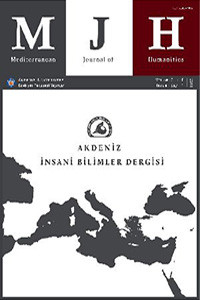Öz
This article draws attention, through quotations cited from contemporary fıgures, to the importance of the shadow plays of the 10th to 14th c. and of the attention drawn to the significance of shadows in the temporal world that is provided by Sura Al-Nahl and Sura Al-Furqan. This is because the key point about the shadow play was and remains its form and the hierarchy of existence that is expressed through its form. The shadow play was and remains a visible expression of tawheed, as "The mover of all was only One", as stated by al-Qadi al-Fadil to Salahad-Din Eyyub in the 12th century.
Anahtar Kelimeler
Kaynakça
- Aminrazavi, M. (2009). The wine of wisdom: The life, poetry and philosophy of Omar Khayyam. Oxford: Oneworld Publication.
- And, M. (1999). Traditional performances in Turkey. The traditional Turkish theater, 39, 7-52. Ankara: Kültür ve Turizm Bakanlığı Yayınları.
- And, M. (2004). An important cultural heritage: Karagöz 13-41 in, Ed. M. Sabri Koz, Yıktın perdeyi eyledin vıran, torn is the curtain, shattered is the screen, the stage all in ruins. İstanbul: Yapı Kredi Karagöz Koleksiyonu, Yapı Kredi Yayınları.
- Arberry, A. J. (1977). Discourses of Rumi, New York: Samuel Weiser.
- Arık, R. (2000). Kubad abad. İstanbul: İş Bankasi Yayınları.
- Arnold, T. W. (1965). Painting in Islam, A study of the place of pictorial art in Muslim Culture. New York: Dover.
Öz
This article draws attention, through quotations cited from contemporary fıgures, to the importance of the shadow plays of the 10th to 14th c. and of the attention drawn to the significance of shadows in the temporal world that is provided by Sura Al-Nahl and Sura Al-Furqan. This is because the key point about the shadow play was and remains its form and the hierarchy of existence that is expressed through its form. The shadow play was and remains a visible expression of tawheed, as "The mover of all was only One", as stated by al-Qadi al-Fadil to Salahad-Din Eyyub in the 12th century.
Kaynakça
- Aminrazavi, M. (2009). The wine of wisdom: The life, poetry and philosophy of Omar Khayyam. Oxford: Oneworld Publication.
- And, M. (1999). Traditional performances in Turkey. The traditional Turkish theater, 39, 7-52. Ankara: Kültür ve Turizm Bakanlığı Yayınları.
- And, M. (2004). An important cultural heritage: Karagöz 13-41 in, Ed. M. Sabri Koz, Yıktın perdeyi eyledin vıran, torn is the curtain, shattered is the screen, the stage all in ruins. İstanbul: Yapı Kredi Karagöz Koleksiyonu, Yapı Kredi Yayınları.
- Arberry, A. J. (1977). Discourses of Rumi, New York: Samuel Weiser.
- Arık, R. (2000). Kubad abad. İstanbul: İş Bankasi Yayınları.
- Arnold, T. W. (1965). Painting in Islam, A study of the place of pictorial art in Muslim Culture. New York: Dover.
Ayrıntılar
| Birincil Dil | İngilizce |
|---|---|
| Konular | Çağdaş Orta Doğu Tarihi |
| Bölüm | Araştırma Makaleleri |
| Yazarlar | |
| Yayımlanma Tarihi | 30 Haziran 2011 |
| Yayımlandığı Sayı | Yıl 2011 Cilt: 1 Sayı: 1 |
| Adres: Akdeniz İnsani Bilimler Dergisi Akdeniz Üniversitesi, Edebiyat Fakültesi 07058 Kampüs, Antalya / TÜRKİYE | E-Posta: mjh@akdeniz.edu.tr |


